CONTENTS
& CONTEXT
In the previous issue of Sub-Mariner,
Namor is forced to choose whether to
first free the captive Lady Dorma or fend
off an attack on Atlantis by Attuma's
forces. He feels obligated to do the
latter first and then finds he is too
late to save Dorma being killed by her
captor Llyra. Now all that Namor can do
is mourn her, and in doing so, his mind
turns back to the days of his youth, and
he remembers events from that time. His
brooding and self-torment is only
interrupted by the Lady Dorma's funeral,
following which Namor publicly announces
his abdication of the throne of Atlantis.
He then leaves, vowing to never to
return.
"The last rites of the
lady Dorma! A soul-wrenching decision
for a tormented Namor! Plus - the
untold truth about the Sub-Mariner's
awesome origin! This is the
one!" (The Mighty Marvel
Checklist, June 1971)
The events featured as memories in Sub-Mariner
#38 all refer to
stories originally written and drawn by
the character's creator Bill Everett,
and writer Roy Thomas thus added an
acknowledgement and dedication
accordingly.

|
|
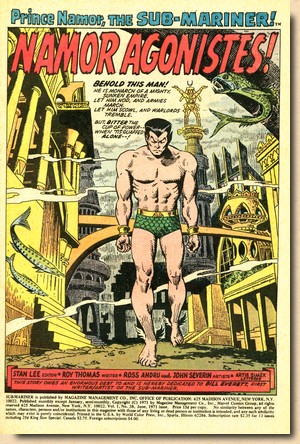 |
|
|
| |
| But this nod of appreciation
came naturally to Thomas, being a self-confessed and
long-standing fan of Marvel's Sub-Mariner and his creator
Everett. |
| |

Roy Thomas
(*1940) in the early 1970s
|
|
Thomas may also have felt
inclined to insert it because he was well aware
that the important place occupied by the
Sub-Mariner and his creator in the history of the
Marvel Universe was not reflected at all in their
general popularity.
"When somebody asks me [Roy
Thomas] in interviews or at conventions about
the many comics titles I've written (...)
it's rarely about The Sub-Mariner. (...) I
find that odd, because Sub-Mariner (...) was
one of my favorite heroes even back in the
late 1940s (...) and he became even more of
an icon to me when his creator Bill Everett
wrote and drew some of the finest Sub-Mariner
stories ever, in the mid-'50s."
(Thomas, 2009)
But then the Sub-Mariner had always swam
against the current.
|
|
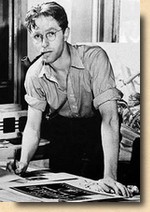
Bill
Everett
(1917-1973)
|
|
| |
| Right from the get-go back in early 1939, the
character constantly swayed between rage and compassion,
between being a hero and a villain - a trait that is
therefore also very present in Sub-Mariner #38,
due to the many memory flashbacks. |
| |
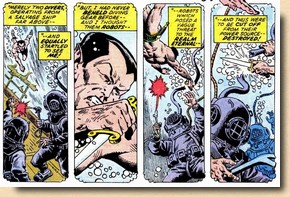 Sub-Mariner #38 (June 1971) Sub-Mariner #38 (June 1971)
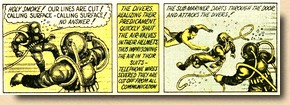
Reprint of
1939 origin story in Invaders #20
(September 1977)
|
|
Ross Andru (born
Rostislav Androuchkevitch) is
probably best known for his work on Spider-Man,
although not unlike the Sub-Mariner he never
quite got the appreciation he deserved for his
work in the historical shadows of the likes of
Steve Ditko, John Romita and Gil Kane (Avila,
2020).
| Andru had worked mostly
for DC since 1953 but left for Marvel in
1970, where his first published pencils
featured in a six-page story in Western
Gunfighters #4 (February 1971)
before being handed his first full-issue
superhero title assignment for Sub-Mariner
#37 (May 1971). Following that Andru became the
artist for the new Kull the Conqueror
title. Sub-Mariner #38
was only his third full-issue work for
Marvel, just as the House of Ideas was
going through one of its bouts of
"creative talent musical
chairs".
|
|

Ross Andru
(1927-1993)
|
Marvel was putting out more and
more titles, and quite often editors found
themselves in dire need of writers and artists,
leading to a substantial amount of moving around
of established creative talent or the
introduction of new names as a result.
|
|
| |
| Newcomer Ross Andru thus replaced Sal Buscema on Sub-Mariner
as of issue #37, but only stayed on for two issues (he
would be back for one issue, Sub-Mariner #43). |
"Sal Buscema left
Sub-Mariner (...) but he had
an able replacement in Ross
Andru. Andru was an
under-valued artist, at least
by many readers, and Stan
himself was only lukewarm
about him. We younger
writers, though, loved to
work with him. He told a good
story, and he constructed
real three-dimensional scenes
you could walk into. It was
admittedly difficult for
anyone to ink his loose
pencils without losing an
ineffable something - but to
us, Ross Andru was a godsend."
(Thomas, 2014)
To Roy Thomas, Namor was the
Marvel solo hero he was most
interested in writing (Thomas,
2014), but he too would become
involved in the creative talent
shuffle and be moved to other
writing responsibilities - after
having authored no less than
issues #1-40 of Sub-Mariner.
Ross Andru continued with Kull
and did a few issues of Rawhide
Kid before being assigned to
pencil the debut of the Defenders
in Marvel Feature #1
(December 1971) - soon to be
followed by his first Spider-Man
assignment, in Marvel Team-Up
#1 (March 1972).
|
|
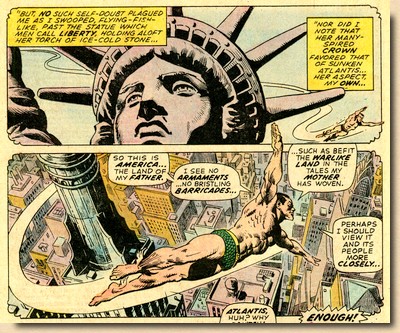
Sub-Mariner
#38 (June 1971) - the
squiggly-rounded panel corners
indicate that this is a memory
|
|
|
|
| |
Thomas' work on Namor with Andru was thus only a
brief interlude, but he rated it highly.
"[In] Sub-Mariner #38 (...) I think Ross
(...) pulled out all the stops [and] also did a
terrific job of retelling Namor's first, fateful and
fatal encounter with two deep-sea divers (conceived
originally by Bill Everett in 1939) which I wanted to
re-tell for new readers." (Thomas, 2014)
|
| |
MARVEL'S
FIRST (ANTI-)HERO
|
| |
There is a distinct disconnect between the
Sub-Mariner arguably being the first Marvel hero (Thomas,
1988) and his standing as a B-list character at best in
the Marvel Universe of the 1960s and 1970s and, indeed,
ever since. Namor has always been a difficult character
to relate to, given his strong ambivalence in personality
- although this in itself makes him an even more
important figure for the nascent new world of comic book
heroes of the early 1960s in the eyes of Roy Thomas.
"In the anti-heroic, almost villainous
mode which was part and parcel of Namor from the
start, and which made him unique among comics heroes
at the time, he was the ancestor of (and doubtless an
influence on) Stan Lee's more human approach to
super-hero scripting which began with Fantastic Four
#1 in 1961." (Thomas, 1988)
|
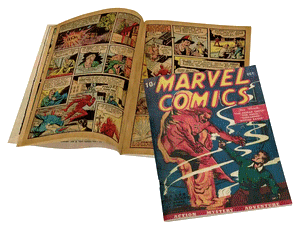
Reprint of Marvel
Comics #1 as suuplement to The Folio
Society's Marvel: The Golden Age
1939–1949 (2019)
|
|
If it were just down to
the Sub-Mariner's well-known first
appearance and origin story from Marvel
Comics #1 (which had an October 1939
cover date but went on sale on August 31st), however,
the Scourge of the Seven Seas would not
be able to lay claim to being Marvel's
first hero, since the Human Torch not
only featured on the cover but also on
the first 16 pages of Marvel Comics
#1 (Namor was only the third feature).
And then there was Ka-Zar in that very
same comic book too. The Sub-Mariner's
tag of "first Marvel hero" is
due to the fact that his origin story had
already appeared before Marvel Comics
#1, in a comic book magazine called Motion
Picture Funnies Weekly #1. Only
rediscovered in 1974, it was designed to
be a promotional giveaway in movie
theatres, but the idea was aborted prior
to distribution and only a handful of
sample copies were actually printed
(Weist, 2004).
Motion Picture Funnies Weekly
#1 featured the first eight pages of
Everett's Sub-Mariner story in black and
white, and information that surfaced with
the few printed copies dates it to April
1939 - making Namor the very first Marvel
Comics character.
|
|
|
| |
| Since the 1990s, the Sub-Mariner's origin tale from
Marvel Comics #1 has been reprinted numerous times, but
prior to that time it was something of a rare gem - if
indeed Marvelites even knew about it. |
| |
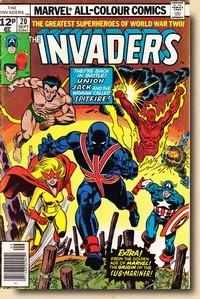
Invaders
#20
(September 1977)
|
|
One rare occasion to get
acquainted with the Prince of Atlantis'
beginnings happened when the
"Deadline Doom" caught up with
Marvel for the production of the
September 1977 cover date publication
run. Several titles missed their
deadlines, and in the case of Invaders
#20, only half of the planned pages made
it into that issue. In true Marvel style,
Roy Thomas (who was the title's editor
and writer) turned an embarrassing
situation into a high-flying event by
using the first eight pages of Namor's
origin story from Marvel Comics
#1 as a filler. Except the reprint wasn't
from that issue, but rather from Motion
Picture Funnies Weekly #1.
Readers were given a comprehensive
explanation of the reasons and the
background story by Thomas, and possibly
many felt the way I remember I did: at
first I was disappointed that the
Invaders story was abruptly cut short,
but ultimately felt I got a good deal
with that Sub-Mariner reprint and the
anecdotal insight into the history of
Marvel Comics.
|
However, if (like
me) you knew Namor from the Roy Thomas and Gene
Colan yarns from the very early 1970s period, you
were in for something of a shock, as this 1939
version of the Sub-Mariner wasn't the tragic yet
noble hero, fighting for the good cause and
recognizing that evil dwells everywhere. On the
contrary - this guy essentially hated everyone
who walked the earth.
|
|
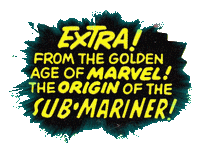
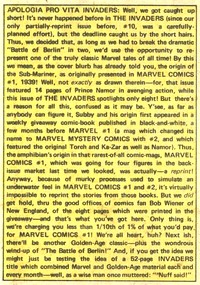
|
|
| |
| It would all be tempered down within a few months, as
Marvel Comics became Marvel Mystery Comics
and the Sub-Mariner began to fight the Nazis just as the
Human Torch and other Marvel heroes did (but of course
readers of Invaders #20 most likely knew nothing
about that). |
| |
The character
nevertheless remained something
of an enigma - as well as a bomb
that could go off at almost any
given moment.
"Namor was a
freak in the service of
chaos. Although the
Sub-Mariner acted like a
villain, his cause had some
justice, and readers revelled
in his assaults on
civilization. His
enthusiastic fans
weren’t offended by the
carnage he created as he
wrecked everything from ships
to skyscrapers."
(Daniels, 1991)
Roy Thomas took him on a
decidedly more refinded path and
imbued him with the best of
humanity as of 1969, but in some
ways he was even lucky the
character was around and a part
of the marvel Universe. When
superheroes started to make a
comeback in the very early 1960s,
Stan Lee was reticent to bring
back the old characters such as
Sub-Mariner, Captain America and
Human Torch, since he really
wanted to create something new
(Cooke, 1998).
|
|
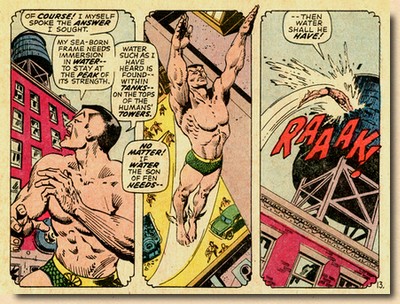
Sub-Mariner
#38 (June 1971)
|
|
|
|
| |
| But as often, publisher Martin Goodman knew like no
other how to make new money with old publications, and so
Lee had to bring the three back into the fold. The fact
that the Human Torch was no longer an android (and thus
had a completely different origin story) and Captain
America was thawed from decades long suspended animation
without his side-kick, and that both characters
immediately started out as members of a team (the
Fantastic Four and the Avengers respectively) was Stan
Lee's way of putting at least some new spin on them, and
since they were successful, Goodman couldn't care less. |
| |
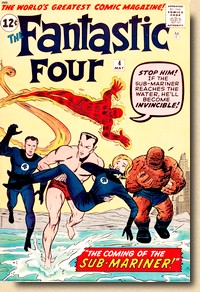
Fantastic
Four #4
(May 1962)
|
|
Like many others, Stan
Lee must have felt rather ambivalent
about Namor, so when he brought him back
into the fold in 1962, it was not as a
hero but as a villain.
And so Johnny
Storm a.k.a The Human Torch reading a
copy of an old Sub-Mariner comic
book and then stumbling across Namor only
moments later sets up "The Coming of
the Sub-Mariner!" in Fantastic
Four #4 (May 1962).
Namor is depicted as having suffered
from amnesia, but contact with sea water
has him regain his memory of who he is
and what he is all about. But when he
finds his undersea home in ruins, and
once again he vows that he will have his
revenge on the human race. Of course it's
up to the Fantastic Four to stop him now,
especially since he joins forces with Dr
Doom in
Fantastic
Four #6 (July 1962), although he
soon finds out he is being played by the
mad doctor from Latveria.
Disillusioned,
he retreats to his marine haunts,
although popping up now and then in
issues of Fantastic Four and Avengers,
where he would continue to have issues
and thus team up with e.g. the Hulk
(suffering from a similarly ambivalent
character). For quite some time, the
Sub-Mariner remained in this state of
being a belligerent villain-hero.
|
|
|
| |
|
| |
| The letters
page "Send it to Subby" (actually two
of them, sharing the space with an in-house ad
for Thor #188) is, as was the case quite
often in those days, revealing in terms not only
of how readers reacted to past issues but also as
to their thoughts regarding future treatment of
the title and its character. |
| |
|
It is
especially interesting to
see that readers were
concerned with ecological
topics and felt that
these should be given
more prominent standing
in Sub-Mariner,
while other readers
brought up the issue of
protests and standing up
for what is right in a
democracy.
Clearly, a
segment of readers of Sub-Mariner
(and other Marvel titles
as well) in the very
early 1970s were very
much concerned with
social, political and
environmental issues, and
were writing in to voice
opinions and thoughts
which went far beyond the
classic evaluation of
plots, artwork and
character treatment.
This was of course
encouraged to quite some
degree by Stan Lee's
musings in his regular Soap
Box column -
featured on the classic
Marvel Bullpen
Bulletin pages -
which famously would
touch on questions of
morality and ethics and
denounce bigotry and
hatred. The message was
simple but effective: you
follow Marvel's good guys
in the comic books, so be
a good guy in real life.
|
|
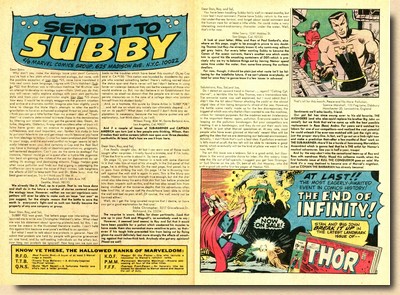
Letters
page from Sub-Mariner
#38 (June 1971)
|
|
|
|
| |
| This time around (i.e. for the May 1971 cover
date production run) Stan Lee was pondering the
relevance of comic books and sharing his
(typically high-flying) thoughts on the subject
matter. |
| |

Bullpen
Bulketins page from Sub-Mariner
#38 (June 1971)
|
|
The actual
Bullpen Bulletins with their
famous ITEM!
bulletin point markers was, as
usual, mostly concerned with ins
and outs of creative talent on
specific titles as well as with
the increasingly common
"show-biz
name-dropping", recounting
media appearances of Stan Lee and
Roy Thomas. |
|
|
| |
| And then,
of course, there was the MIGHTY
MARVEL CHECKLIST,
featuring a run-down of
titles from the House of
Ideas on sale at that
point in time. As always,
it included a number of
enticingly worded plugs
for several titles, as
well as letting readers
know that Marvel still
put out titles such as Our
Love Story or Western
Gunfighters in early
1971. |
|

Sub-Mariner
#38 (June 1971)
|
|
|
|
|
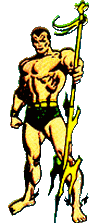 |
|
Everett
got the inspiration for
the name Sub-Mariner from
Samuel Taylor Coleridge's
1834 poem Rime of the
Ancient Mariner
(Thomas, 1989);
Roy
Thomas' title "Namor
Agonistes!"is an
allusion to John Milton's
1671 drama Samson
Agonistes, the Greek
agonistes
referring to a person
engaged in an inner
struggle;
Sub-Mariner
was published
monthly in 1971, but the
indicia wrongly states
that it is
"published monthly
except January,
semi-monthly".
Despite
his interest in and love
for the Sub-Mariner, Roy
Thomas would not get to
write his adventures
again after leaving the
character with Sub-Mariner
#40, although he would of
course include Namor in
the WW2 Invaders.
|
|
|
|
| |
|
| |
 |
| |
|
| |
| BIBLIOGRAPHY AVILA Mike
(2020) "Remembering Ross Andru, the most under-appreciated Spider-Man
artist", Syfy
Wire, published online
COOKE Jon B.
(1998) "Stan the Man & Roy the Boy: A
Conversation Between Stan Lee and Roy Thomas", in Comic Book Artist #2,
Summer 1998
DANIELS,
Les (1991) Marvel: Five Fabulous Decades of
the World's Greatest Comics, Harry N. Abrams, Inc.
THOMAS
Roy (1988) "Subby, Bill and Me - A Personal View by
Roy Thomas", Saga of the Sub-Mariner #1,
November 1988
THOMAS
Roy (1989) "Subby, Bill and Me - A Personal View by
Roy Thomas, Part VII", Saga of the Sub-Mariner #8,
February 1989
THOMAS Roy (2009)
"Introduction", in Marvel Masterworks The
Sub-Mariner, Vol. 3, Marvel
THOMAS Roy (2014)
"Introduction", in Marvel Masterworks The
Sub-Mariner, Vol. 5, Marvel
WEIST Jerry (2004) 100 Greatest
Comic Books, Whitman Publishing
|
| |
| |
The
illustrations presented here are
copyright material.
Their reproduction for the review and
research purposes of this website is
considered fair use
as set out by the Copyright Act of 1976,
17 U.S.C. par. 107.

(c) 2023
|
|
|
|
